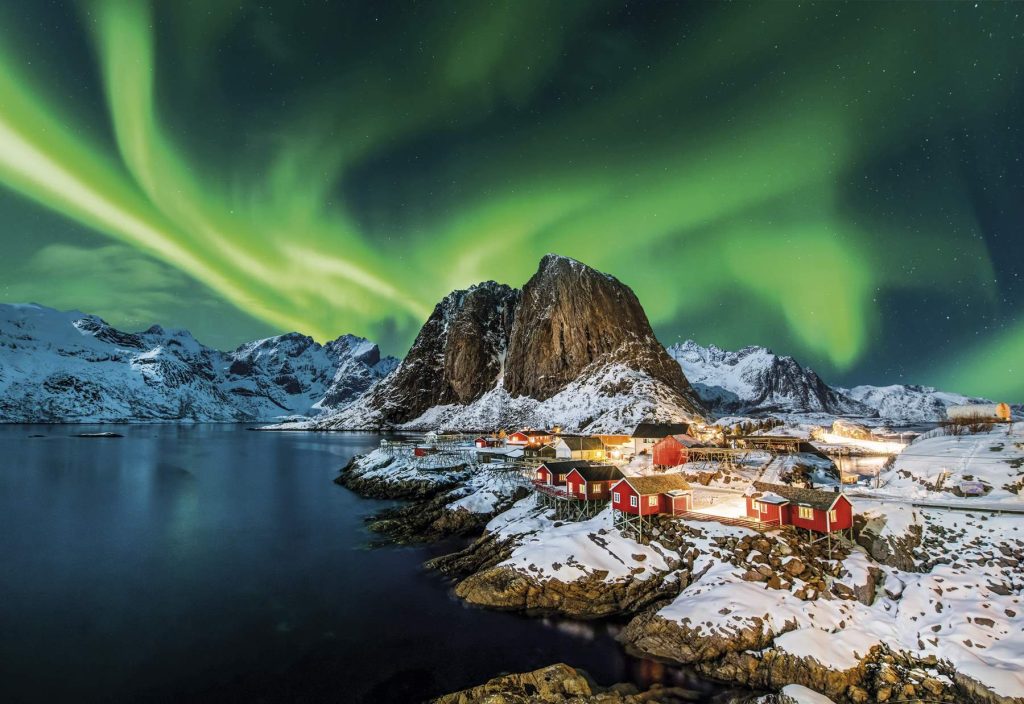
Dog Sledding and Northern Lights in Finnish Lapland
Northern Finland is a prime winter destination, perfect for dog sledding and witnessing the northern lights. The Arctic Circle shines during this time of the year. The landscape is covered in snow, and the lakes freeze over. The polar night (24 hours of darkness) is a unique experience, as well as the return of the sun and the dancing northern lights. According to the Finnish Meteorological Institute, the best time to see them is from February to March and from September to October. It’s also an excellent time for outdoor activities. Though it’s still cold, temperatures begin to rise, and lodges offer comprehensive activity programs to warm up: dog sledding, snowmobiling, sleigh rides, snowshoeing, cross-country skiing… And if the cold still gets to you, the best option is to visit a traditional Finnish sauna.
Rovaniemi and Ivalo airports provide access to the northern part of the country, and more and more travelers are seeking this time of the year (from September to April) to see the northern lights. In fact, many lodges offer aurora alerts, waking guests up in case they appear.
Ice and Fire in Icelandic Fjords
Iceland is a must-visit destination at least once in a lifetime, and the chosen time is usually summer. However, more and more people are trying to find a time with fewer tourists. In winter, there are other attractions, although you’ll have to move around in darkness. If what you’re looking for is simply a bit of cold, you can find it any time of the year in this land of ice and fire: explosive geysers, boiling mud pools, glaciers carving their way through mountains, turquoise lakes with floating glacier pieces… It’s also a perfect place for whale watching, bathing in geothermal pools amidst the ice, hiking on ice, and seeing how the planet continues to form.
A very special region is the Westfjords, the northwest corner, shaped like a reindeer’s horn. Its fjords, glacial valleys, and icy cliffs are spectacular. The completion of the Dýrafjörður tunnel in 2020 opened a new road route, the Vestfjarðaleiðin: a 950-kilometer circular route that is a peaceful alternative to the popular Ring Road. It’s a good idea to cover it in the height of summer: good weather is not guaranteed, but the roads are clear, it never gets dark, and puffins and other birds breed on the cliffs of Látrabjarg. You’ll need to leave the car to explore the area on foot and spot the Arctic fox among the orchid forests of the Hornstrandir nature reserve, see seals on the pink beach of Rauðasandur, bathe in the geothermal pool of Drangsnes, admire the Drangajökull glacier, and the spectacular Dynjandi waterfalls.
The winter in these remote lands of the wild west of Iceland, the nights are long enough to maximize the chances of seeing a northern lights, and when the days lengthen, there is enough light to go whale watching. The Snæfellsnes Peninsula is another place with surprises: this piece of land that juts out into the North Atlantic has a great offer of activities between lava flows, stegosaurus ridges—Kirkjufell, over Grundarfjörður, must be the most photographed peak in Iceland—and the spectacular Snæfellsjökull glacier, which inspired Jules Verne’s epic Journey to the Center of the Earth.
The Irresistible Attraction of Antarctica
Antarctica Peninsula ensures cold temperatures, a dream destination for adventure lovers. Trips are usually made in our winter (southern summer, from November to March), to enjoy, with hardly any night, an immense white landscape at the ends of the world. Here, summer brings with it temperate days that never end, when the temperature rises to zero degrees or more in the middle of the southern summer. In January, you can see and hear large and noisy colonies of penguins, with their chicks—born with the new year—begging for food, and also seal pups in South Georgia, while whale sightings occur at the end of the month. Good weather is never guaranteed, not even in the Drake Passage, between Tierra del Fuego and the peninsula, but at least in January, it is possible to sail among colossal icebergs and large cliffs while the sun shines on the water and the ice.
Almost all ships to the Antarctic Peninsula depart from Ushuaia, in the archipelago of Tierra del Fuego, in southern Argentina, and take between 11 and 14 days. If you visit South Georgia, the trip lasts a few more days.
Winter in Canada
What time of year is Canada most spectacular? In winter, when snow covers mountains, forests, and plains. The thermometer registers temperatures below zero, but if you contemplate the epic landscape from the comfort of a heated train carriage with a glass roof, what more could you ask for? This is what The Canadian offers, the train that travels 4,466 kilometers from Toronto to Vancouver in four days and four nights, passing through Winnipeg, Saskatoon, Edmonton, Jasper, and Kamloops, and covers the route twice a week all year round. Perhaps you’ll want to get off to see Niagara Falls covered in ice or detour along the Icefield Parkway to the heart of the Rocky Mountains, from Jasper to Banff. For a more authentic experience, you can
ski, snowboard, or snowshoe at Lake Louise, Jasper, or Whistler. But don’t forget to visit the enchanting cities of Montreal, Quebec, and Ottawa. And, if you can, take a helicopter ride over Niagara Falls to see it all from above.